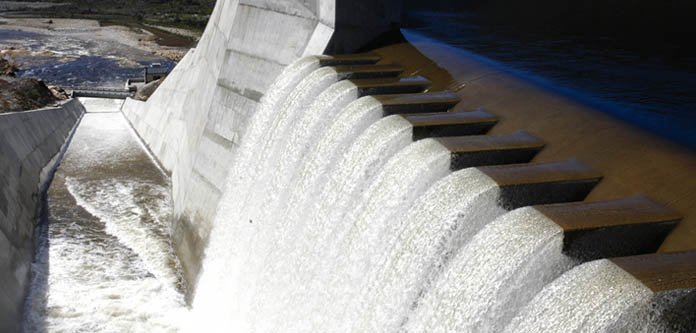Water projects in South Africa have receive a major boost after the government rolled out about US $6.5 billion for water projects across the country.
The government of South Africa has outlined several infrastructure projects that have been declared strategically important, including municipal rezoning and water rights.
Millions of dollars have been committed under schedule 6b to continue with the implementation of 136 bulk water and sanitation projects, and schedule 5b to implement 69 projects of which both schedule 5b and 6b are municipal grants, which fall under the regional bulk infrastructure grant.
Regional bulk water services infrastructure plays a key role in bringing water services to the people. Some of the water projects in South Africa include:
Vaal River System including Phase 2 of the Lesotho Highlands Water Project: Gauteng
Vaal River has been undergoing rehabilitation after the river was polluted by raw sewage from pump stations. The works were launched in 2019 with an investment of about US $24.3 million and are currently being carried out by East Rand Water Care Company (Erwat). The project includes the rehabilitation of Sebokeng wastewater treatment plant which has a capacity of 50,000 cubic metres per day, the rehabilitation of this facility consists of demolishing existing water reservoirs to build new ones.
Also, the construction of Lesotho Highlands Water Project (LHWP) Phase II has kicked off with a ground breaking ceremony recently presided over by South Africa minister for Human Settlements, Water and Sanitation, Lindiwe Sisulu and her Lesotho counterpart.
READ: Lesotho Highlands Water Project to supply SA by 2026
The Project consists of the Polihali Dam -concrete-faced rock-fill dam located about a kilometre downstream the confluence of the Senqu (Orange) and Khubelu Rivers in Mokhotlong District.
The Polihali Dam construction project, part of Phase II of the Lesotho Highlands Water Supply Project, was initiated in 2019 and is aimed at achieving water security and delivering water to South Africa by November 2026.
Phase 2A of the Mokolo Crocodile River (West) Augmentation Project: Limpopo
Mokolo Crocodile Water Augmentation Project (MCWAP) entails construction of two main bulk raw water transfer systems to meet the growing demand for power generation, mining activities and domestic use in the Lephalale area in South Africa.
Phase 1 comprises a 4.5 MW pump station and 46 km (of up to 1 100 mm diameter) pipeline, delivering approximately 30 million cubic metres of water per annum, taken from the Mokolo Dam in the mountains south of Lephalale. This infrastructure was constructed parallel to, and tying in with, existing infrastructure supplying Exxaro’s Grootegeluk Mine, Eskom’s Matimba and Medupi Power Stations, and the Lephalale Local Municipality.
Phase 2 will include an abstraction weir in the Crocodile River, de-gritting channels with high and low lift pump stations, and approximately 160 km of pipeline with break pressure and balancing reservoirs. This will ensure more water to the local municipality – and secure water for the Medupi and Matimba power stations. It will also supply water to surrounding mines.
uMkhomazi Water Project: KwaZulu-Natal
The uMkhomazi Water Project, upon completion, will be one of the largest bulk water infrastructure schemes constructed and operated in South Africa. It will deliver 600-million litres of water per day and alleviate pressure on dams such as Midmar in Howick. The dam will supply both the south coast and parts of Durban.
READ: General Electric appoints new CEO for Southern Africa
Olifants River Water Resource Development Project – Phase 2: Limpopo
The Olifants River Water Resources Development Project is an extensive water resource development project which will supply water for domestic and industrial (mining) use in the Limpopo Province. Phase 1 of the project, encompassed the raising of the Boshielo Dam.
Phase 2 which is divided into two main schemes will comprises a 70km long, 1100mm diameter pumping main from the Flag Boshielo Dam to the town of Mokopane, for which three pump stations of 4MW each are required in first scheme
The second scheme consists of the extraction and distribution of water from the De Hoop Dam to various end points via pipelines ranging from 1700mm to 1000mm in diameter. One 13MW pump station is required along the 110km of pipeline.
Vaal-Gamagara: Northern Cape
Vaal Gamagara Water Supply Scheme in the Northern Cape is expected to meet water demands up to the year 2030. The water project includes the refurbishment of the existing Vaal Gamagara Water Treatment Plant near Delpoortshoop, the upgrade of pump stations and the construction of a 430-km long pipeline to run from Delpoortshoop to Black Rock.
Mzimvubu Water Project: Eastern Cape
Mzimvubu water project has two multi-purpose dams on the Tsitsa River, a major tributary to the Mzimvubu River. To make the scheme sustainable throughout its life, the two dams will be operated and built as one integrated scheme.
The Mzimvubu Water Project has been classified as a Strategic Integrated Project to facilitate the allocation of sufficient water resources.
ALSO READ: LH Marthinusen acquires modern mine ventilation testing facility
Rehabilitation of the Vaalharts-Taung Irrigation Scheme: Northern Cape & North West
The Vaalharts scheme is the largest irrigation scheme in South Africa, with approximately 32,000ha of land under irrigation. The scheme sees water from a diversion weir in the Vaal River flowing through an 812km long network of canals to water approximately 1250 farming units within the scheme. These vary in size from 25ha to 75ha.
During recent years it became evident that the condition of the water supply infrastructure had deteriorated and the effect of water logging had increased to such an extent that continued agricultural production on the land was severely affected.
The project is ongoing and will help to underpin the ongoing performance of the Vaalharts irrigation scheme as a major water resource asset to surrounding communities.

